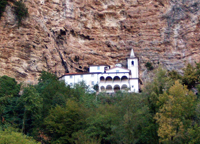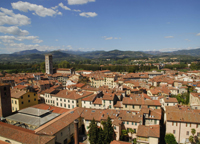
Klause von Calomini

The Hermitage of Calomini, a short walk from the farm, is nestled under a huge overhanging rock cliffs. The church was built hugging the side of the mountain, and more than half, the sacristy and most of the convent, remains excavated into the mountain, with only the use of a chisel. The top of this excavation ends in a very wide dome. Dating from the eleventh century, has been many interventions in the history of expansion especially in the 700, when the community of monks was built and expanded a lot the double colonnade, enlarged the cave to receive the sacristy of the church and placed on the floor completed every detail that would help make this place worthy of admiration of prayer. It seems that in a place where today the rocks give pure water, the image of the Virgin Mary who is venerated in a shrine, turned to a girl from Calomini. For this reason the shrine is dedicated to the Marian cult and has always been many pilgrimages.
The hermitage of Calomini is located along the road to the village of Vergemoli, above the village of Gallicano.
Grotta del Vento

Die Windhöhle bietet dem Besucher 5 Rundgänge zur Auswahl an, die alle unterschiedlich in Aussehen, Länge und Dauer sind. Der Erste Rundgang dauert eine Stunde, der Zweite (umfaßt ebenfalls den Ersten) zwei Stunden und der Dritte eine Stunde und 15 Minuten. Die Dauer des Vierten Rundgangs beträgt drei Stunden - hier werden der Dritte und der Zweite Rundgang zusammengelegt; der Fünfte Rundgang dauert zwei Stunden und umfaßt den Dritten und den Ersten Rundgang. Keine andere europäische Schauhöhle kann eine solch große Vielfalt von Aspekten, eine so große Auswahl an Rundgängen und eine mit der des Vierten Rundgangs vergleichbare Länge bieten. Die Grotta del Vento ist an allen Tagen des Jahres geöffnet (25. Dezember ausgeschlossen). In der Zeit zwischen dem 1. April and dem 1. November, dem 26. Dezember und dem 6. Januar and an allen Festtagen der restlichen Zeit gelten folgende Besuchszeiten: 1. Rundgang: 10, 11, 12, 14, 15, 16, 17, 18 Uhr 2. Rundgang: 11, 15, 16, 17 Uhr 3. Rundgang: 10, 14 An den Wochentagen zwischen dem 2. November and dem 24. Dezember, zwischen dem 7. Januar and dem 31. März wird nur der erste Rundgang angeboten (Dauer 1 Stunde): 10; 11; 12; 14; 15; 16; 17; 18. Für organisierten Gruppen über 20 Personen (Reisebüros, Schulklassen, Firmen, Kirchengemeinden, Vereine, Militäreinheiten) sind Besuche an allen Tagen des Jahres möglich, wobei die Besuchszeiten frei vereinbart werden können. Es wird jedoch um rechtzeitige telephonische Anmeldung gebeten.
Anmeldungen und weitere Informationen unter folgender Anschrift: Direzione "Grotta del Vento" I-55020 Fornovolasco (LU) Telefon: +39-0583-722024 +39-0583-722024 Telefax 722053 E-mail:info@grottadelvento.com web site www.grottadelvento.com
Die Innentemperatur beträgt etwa 11 ° C und sind notwendig für den Besuch Wintermantel und geeignete Kleidung.
Apuan Alps and Monte Forato

The Apuane Alps are one of the most special and original mountain areas of the Italian peninsula, for the richness of the environments and landscapes that include. Their particular geological structure (metamorphic rocks with almost pure stone, such as marble), the unique geographical position and the presence of man to the highest altitudes have resulted in a set of elements of biodiversity and landscapes that make it the paradise of botanists, the cavers, hikers and mountain climbing. Protected by more than twenty years from a regional park, the Alps are accompanied by an extensive network of trails maintained by the Italian Alpine Club (CAI), now included in the network of footpaths Tuscany (RET) that allow stepper admire them in all their suggestive beauty.
One of the most charming and details of the Alps and the Holed Mountain, a natural arch of rock eroded by the time. Is a place for a breathtaking view of the Tyrrhenian coast. The trail starts from Fornovolasco (Vergemoli) is only a fifteen minute drive from our farm.
Lucca and it's walls

Reached in about an hour's drive from the farm, Lucca welcomes you with its charming Renaissance city walls on which you can walk around the green or you can visit the churches, the museums with many art and historical documents, the typical squares and towers that tell us of times past.
The sixteenth-century walls of Lucca is the only example of defensive architecture still intact and contain a historic monument of rare beauty to be discovered step by step along the narrow streets that open in to the anfiteatro square that was founded on the ruins of the Amphitheatre Roman. Or Piazza San Martino, where you can see in the magnificent cathedral the Holy Face.

 Antica Trattoria dell'Eremita
Antica Trattoria dell'Eremita


